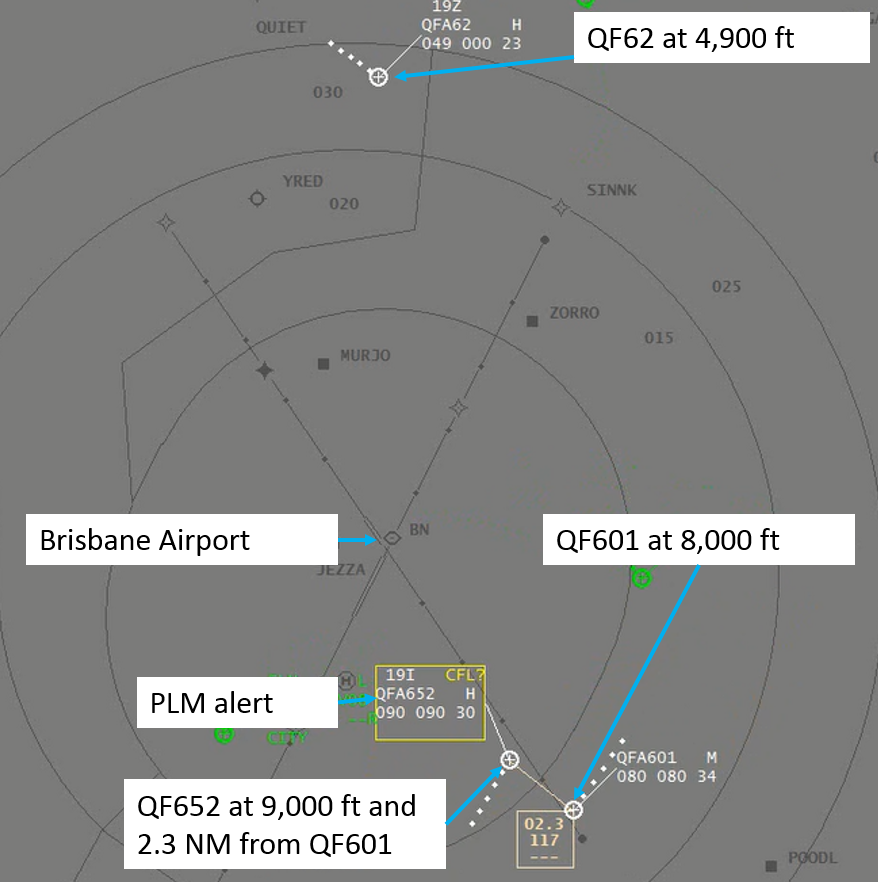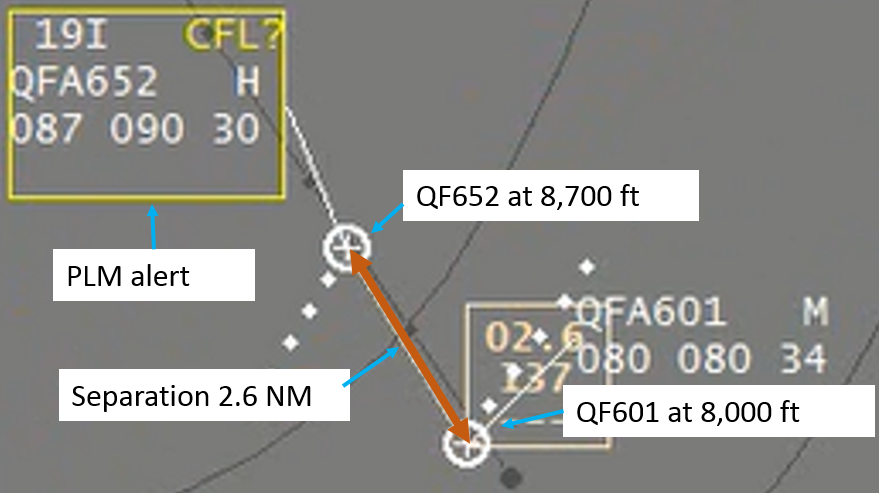What happened
On 15 December 2016, an Airbus A330-202 aircraft, registered VH-EBA and operating Qantas Flight (QF) 652, was on descent to Brisbane Airport, Queensland, arriving from the south-west from Perth, Western Australia. QF652 was sequenced to follow another Qantas Airbus A330-303 aircraft, registered VH-QPG and operating QF62, which was also on descent to Brisbane Airport, but arriving from the north-west from Narita, Japan.
For noise abatement, reciprocal runway operations were in progress at Brisbane, with arriving aircraft landing on runway 19, and departing aircraft taking off from runway 01.
At 0516:25 Eastern Standard Time (EST), the approach controller cleared QF62 to descend to 5,000 ft.
At 0517:55, a Qantas Boeing 737-838 aircraft, registered VH-VXF and operating QF601, (departing Brisbane for Melbourne, Victoria) took off from runway 01 and was tracking to the south-west. At 0519:15, the approach controller cleared QF601 to climb to 8,000 ft.
Five seconds later, the approach controller cleared QF652 to descend to 9,000 ft for separation with QF601 travelling in the opposite direction. The controller advised the crew of QF652 that they would be cleared for further descent once they had passed opposite direction traffic. The controller then also advised the flight crew of QF601 that there would be a short delay at 8,000 ft due to opposite direction traffic above.
At 0520:20, the controller inadvertently cleared QF652 (instead of QF62) to descend to 2,500 ft and conduct an ILS approach to runway 19. The crew of QF652, still on descent to 9,000 ft, read back the clearance and set their assigned altitude to 2,500 ft (which was normal procedure having been cleared for the descent). The crew sighted the opposite direction aircraft out to their right and continued their descent.
About 30 seconds later, the air traffic system identified a discrepancy between the controller-cleared flight level of 9,000 ft and the flight crew-entered altitude of 2,500 ft. The controller received a predicted level mismatch (PLM) alert, which displays as ‘cleared flight level (CFL?)’.[1] The controller asked the crew of QF652 to confirm they were maintaining 9,000 ft, and the crew responded that they were on descent to 2,500 ft as cleared. The aircraft was passing 9,200 ft at this stage. The controller immediately responded ‘no, that was for Qantas 62, Qantas 652 maintain 9,000’. By that time, radar data indicated that QF62 was at 4,900 ft. No read back was heard from the crew of QF62 to the clearance inadvertently issued to QF652.
The flight crew of QF652 reported that they were passing about 8,600 ft, when the controller instructed them to maintain 9,000. The crew stopped the descent and climbed the aircraft back up to 9,000 ft. The crew received a traffic alert[2] for about 5 seconds on the reciprocal aircraft. At 0521:19, the controller cleared the flight crew of QF652 to descend to 8,000 ft and the aircraft subsequently conducted a normal approach to Brisbane.
Figure 1: Traffic disposition and PLM alert

Source: Airservices Australia – annotated by ATSB
Safety analysis
Separation
As the two aircraft passed each other, radar data showed QF652 at an altitude of 9,000 ft and QF601 at 8,000 ft, with 2.3 NM lateral separation (Figure 1). Figure 2 shows QF652 at 8,700 ft and lateral separation with QF601 of 2.6 NM (Figure 2). The incorrect descent clearance resulted in a loss of separation with QF601, where the separation required was 3 NM or 1,000 ft and the minimum separation recorded was 2.5 NM and 700 ft.
Figure 2: Loss of separation

Source: Airservices Australia – annotated by ATSB
Controller comments
The approach controller had been in the position since 0200 and reported feeling alert, well rested and that things were going very well in the minutes prior to the incident in adhering to noise abatement requirements and keeping the traffic moving. The controller commented that between 0500 and 0600 they get busy; departures tend to conflict with arrivals and traffic can be quite complex at times. The controller assessed that their workload at the time was moderate.
The controller commented that when they identify similar call signs, there are techniques they employ such as appending ‘heavy’, or the aircraft’s position in the sequence, to the call sign, but did not do that in this instance. Both inbound aircraft were ‘heavy’ so it would not have helped to resolve the possible confusion.
After giving the clearance (inadvertently) to QF652 that was meant for QF62, both aircraft appeared to descend.[3] When the flight crew read back ‘Qantas six fifty two’, the controller did not identify the mismatch of the data in the aircraft label with the response, possibly because it was the expected response to the clearance instruction.
Flight number call signs
According to the Australian Aeronautical Information Publication (AIP) General 3.4 paragraph 4.17, rules for aircraft call signs include that flight numbers should ‘take into account flight numbers already in use by the operator and other agencies in the intended control environment, operational area or nearby’.
Call sign confusion
The Manual of Air Traffic Services (MATS) 6.2.1.1 Callsign confusion stated:
When similar callsigns may cause confusion you may take action to minimise errors including:
a) emphasising certain numbers/letters;
b) repeating the entire callsign e.g. QANTAS451 QANTAS451;
c) repeating the prefix e.g. QANTAS451 QANTAS;
d) advising pilots that there are aircraft with similar callsigns on frequency; or
e) instructing pilots to use a different callsign either temporarily or for the duration of the flight.
Airservices Australia initiative
After a number of REPCON (confidential reports) related to flight number call sign confusion in the Brisbane area, Airservices Australia (Airservices) established a process to monitor and increase awareness of reported call sign confusion issues. The process involves reviewing the call sign confusion occurrences reported through their internal reporting system and notifying relevant airlines of the reported occurrence. In addition, Airservices provides a ‘call-sign conflict report’ to domestic aircraft operators each month.
Airservices advised that the distribution of the monthly call sign confusion reports to domestic operators was paused in 2016. This was to allow for an upgrade to an improved information system as the basis of the report. However, given a new system has yet to be commissioned Airservices has reinstated use of the previous system, and will continue to distribute monthly call sign confusion reports while working on improvements to the advice provided to industry.
Airservices also commented that a number of current mitigation measures currently exist for pilots and controllers to respond to call sign confusion, including documented AIP and MATS procedures to minimise the likelihood of call sign confusion. Additionally, Australia utilises 'group format' as the preferred means of transmitting call sign/flight number within Australian airspace in an effort to reduce the possible confusion with assigned flight levels or headings.
Findings
These findings should not be read as apportioning blame or liability to any particular organisation or individual.
- The controller inadvertently assigned descent to QF652 instead of QF62 due to call sign confusion, resulting in a loss of separation with QF601.
- The two inbound aircraft were operating on the same frequency with similar call signs and call sign confusion mitigation strategies were not used by air traffic control.
ATSB comment
According to the article Callsign Confusion, the US Aviation Safety Reporting System (ASRS) receives a large number of reports of call sign confusion, some of which result in losses of separation. The article states that communications technique is pilots’ and air traffic controllers’ primary defence against confusion and that they need to continue to bring call sign problems to the attention of management.
The Skybrary article Call-sign confusion lists contributory factors including:
- failure of operator to give sufficient consideration in allocation of call signs
- pilot and controller workload
- interruption or distraction
- airspace and procedure design
- traffic density.
Safety message
Air traffic control and flight crew need to be vigilant when they identify the potential for call sign confusion.
Flight numbers are assigned by airlines, some of which operate call sign de-confliction programmes. The ATSB encourages aircraft operators to use these strategies to help prevent similar incidents occurring. Air traffic control is encouraged to consider liaising with airlines to enhance call sign de-confliction programmes.
Aviation Short Investigations Bulletin - Issue 59
Purpose of safety investigationsThe objective of a safety investigation is to enhance transport safety. This is done through:
It is not a function of the ATSB to apportion blame or provide a means for determining liability. At the same time, an investigation report must include factual material of sufficient weight to support the analysis and findings. At all times the ATSB endeavours to balance the use of material that could imply adverse comment with the need to properly explain what happened, and why, in a fair and unbiased manner. The ATSB does not investigate for the purpose of taking administrative, regulatory or criminal action. TerminologyAn explanation of terminology used in ATSB investigation reports is available here. This includes terms such as occurrence, contributing factor, other factor that increased risk, and safety issue. Publishing informationReleased in accordance with section 25 of the Transport Safety Investigation Act 2003 Published by: Australian Transport Safety Bureau © Commonwealth of Australia 2017
Ownership of intellectual property rights in this publication Unless otherwise noted, copyright (and any other intellectual property rights, if any) in this report publication is owned by the Commonwealth of Australia. Creative Commons licence With the exception of the Coat of Arms, ATSB logo, and photos and graphics in which a third party holds copyright, this publication is licensed under a Creative Commons Attribution 3.0 Australia licence. Creative Commons Attribution 3.0 Australia Licence is a standard form licence agreement that allows you to copy, distribute, transmit and adapt this publication provided that you attribute the work. The ATSB’s preference is that you attribute this publication (and any material sourced from it) using the following wording: Source: Australian Transport Safety Bureau Copyright in material obtained from other agencies, private individuals or organisations, belongs to those agencies, individuals or organisations. Where you wish to use their material, you will need to contact them directly. |
__________
- The PLM alert will display when there is a system-detected difference between the controller-entered CFL and the altitude/level entered by the pilot into the aircraft’s control systems (from suitably equipped aircraft – with mode S transponder).
- Traffic advisory (TA): an alert issued by the traffic alert and collision avoidance system (TCAS) when the detected traffic may result in a conflict. Pilots are expected to initiate a visual search for the traffic causing the TA.
- While QF62 maintained 5,000 ft, the altitude readout observed by the controller indicated 4,900 ft. The controller interpreted the 4,900 ft displayed as the aircraft descending.


